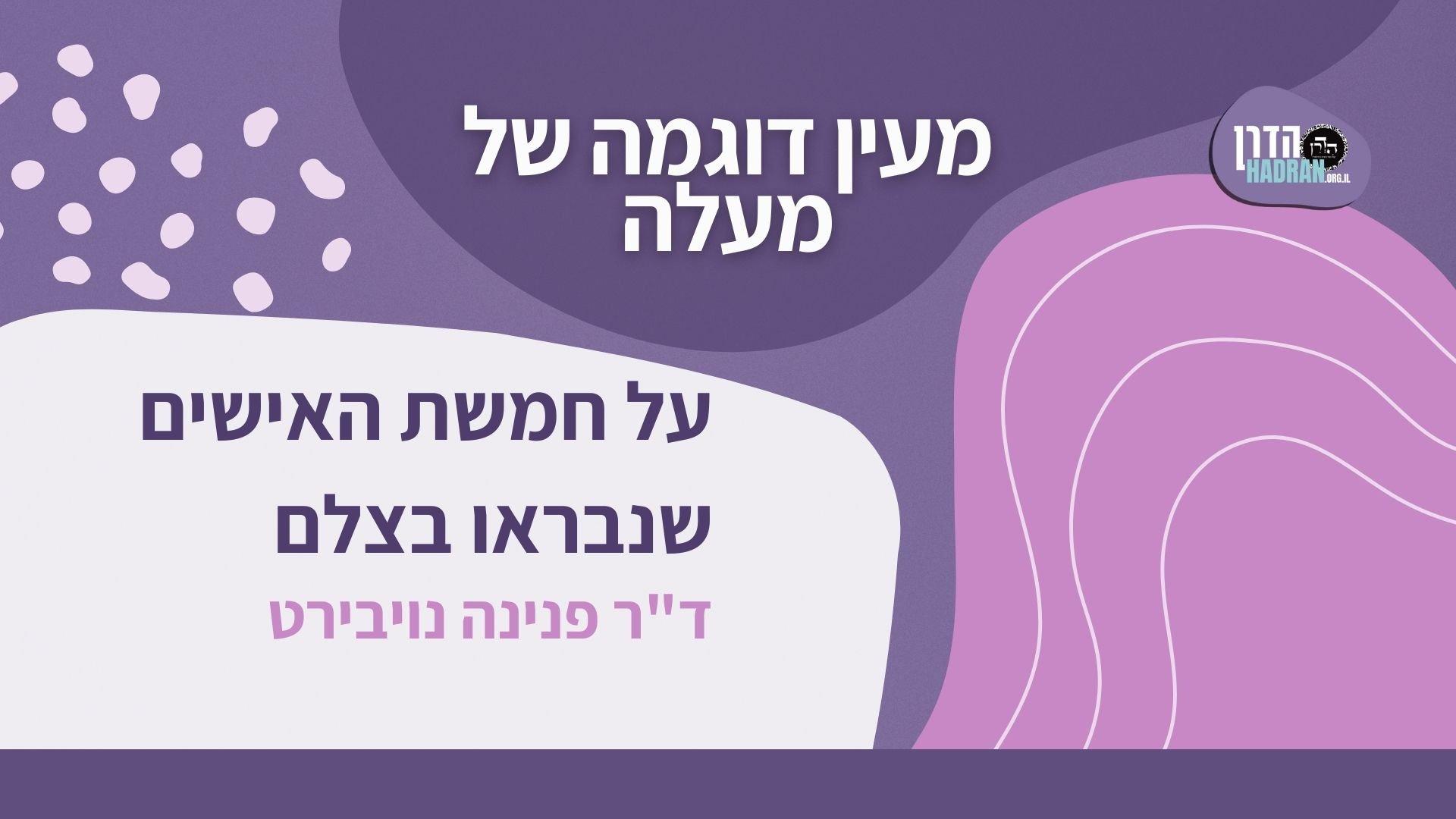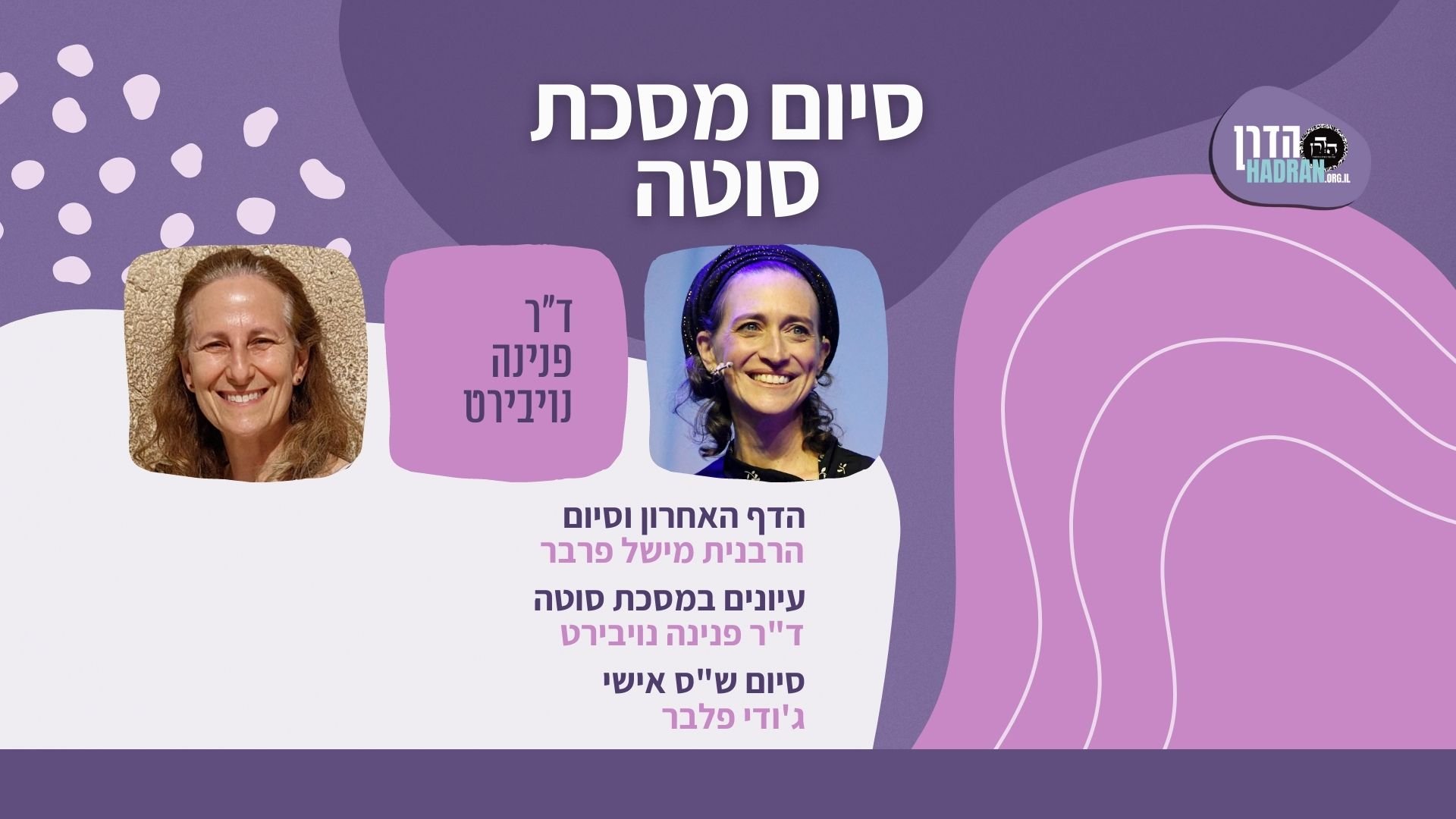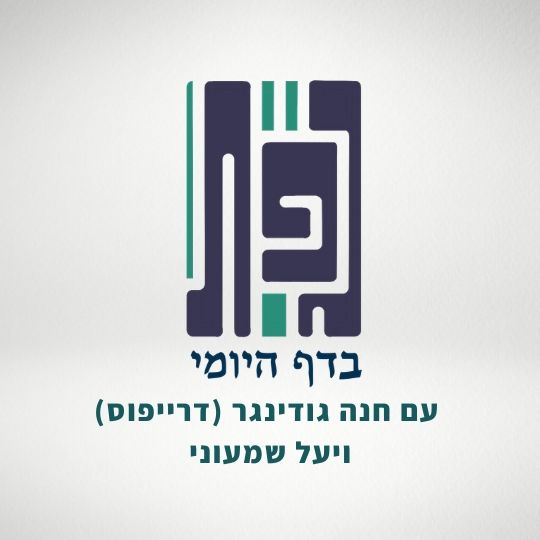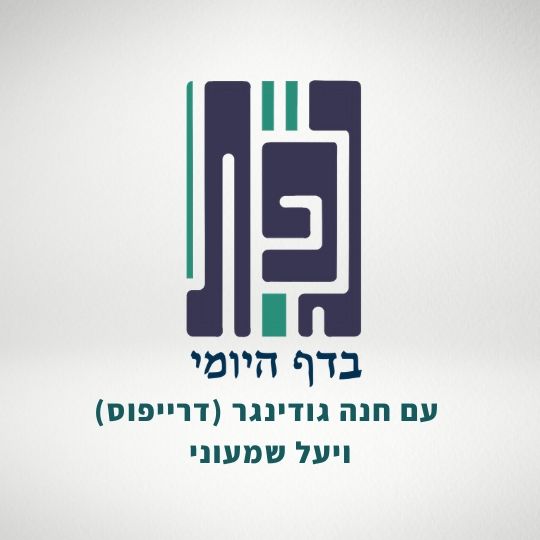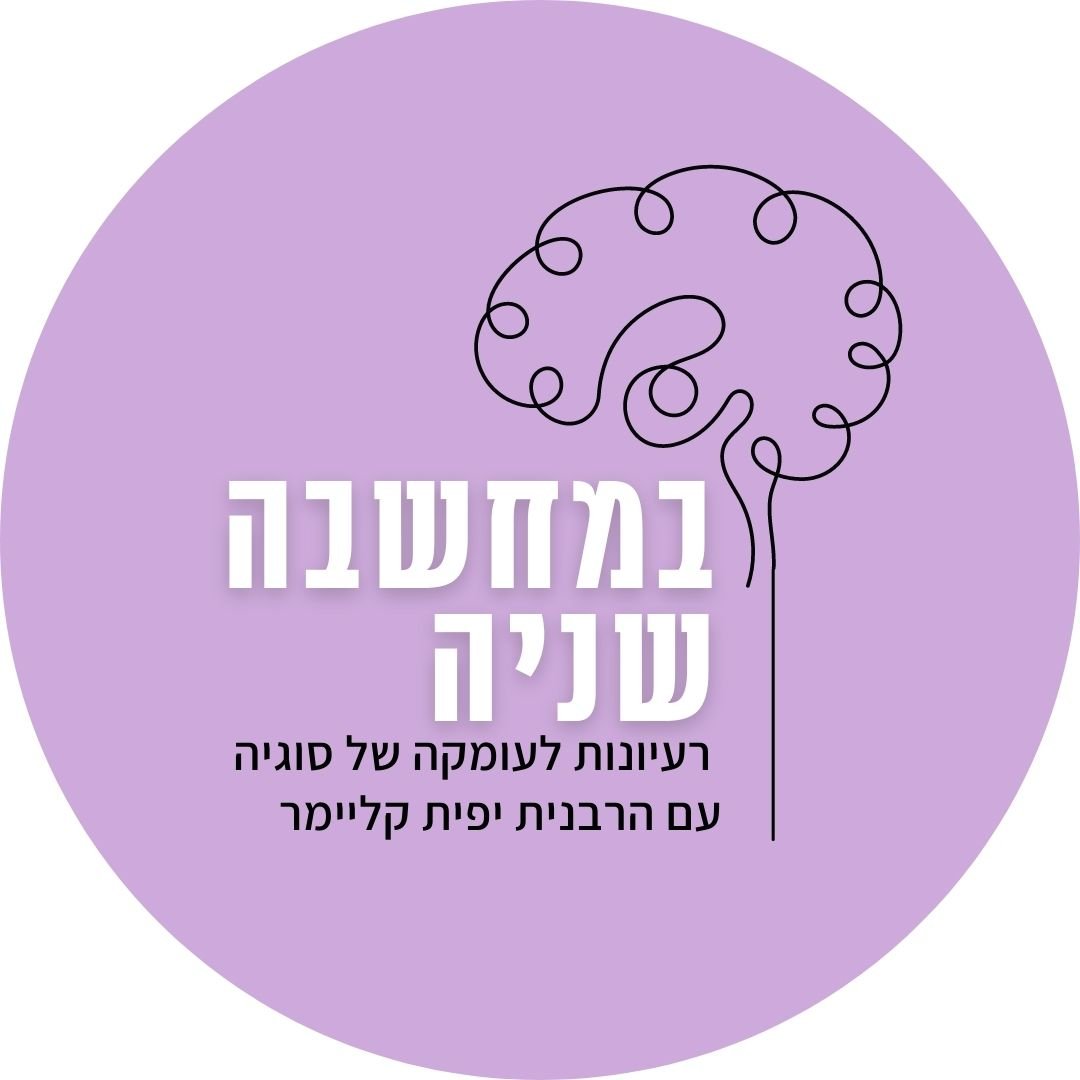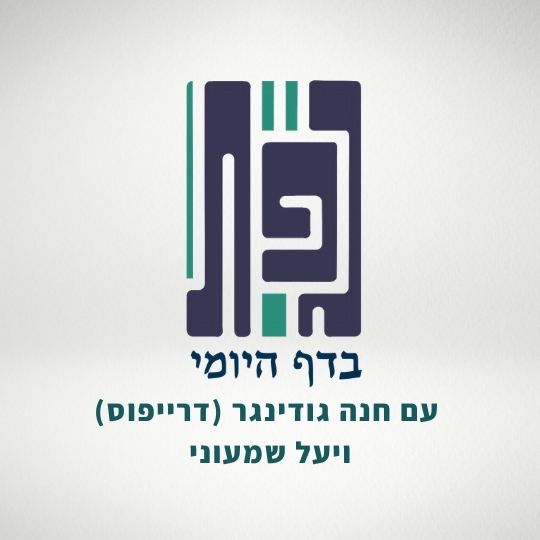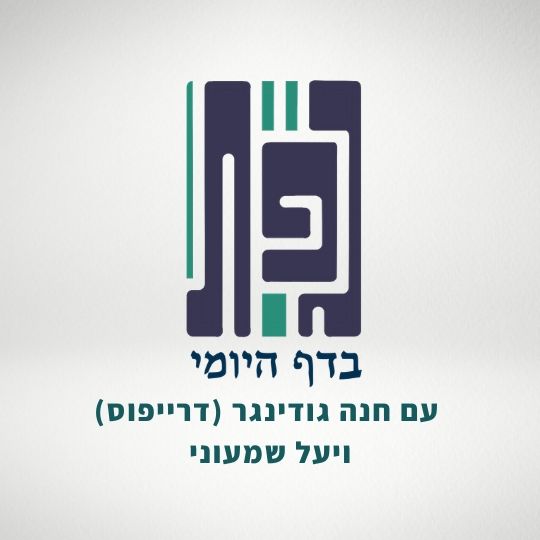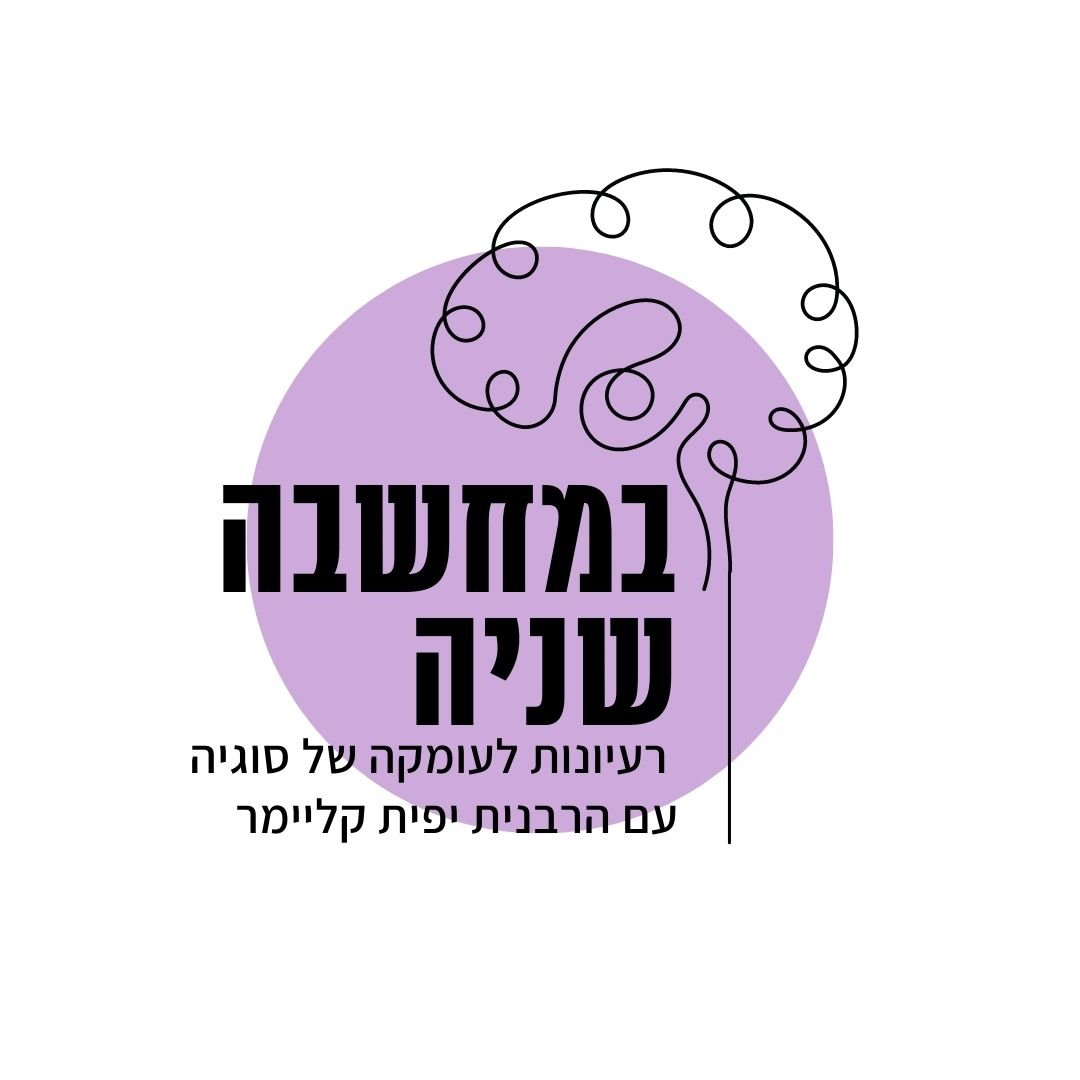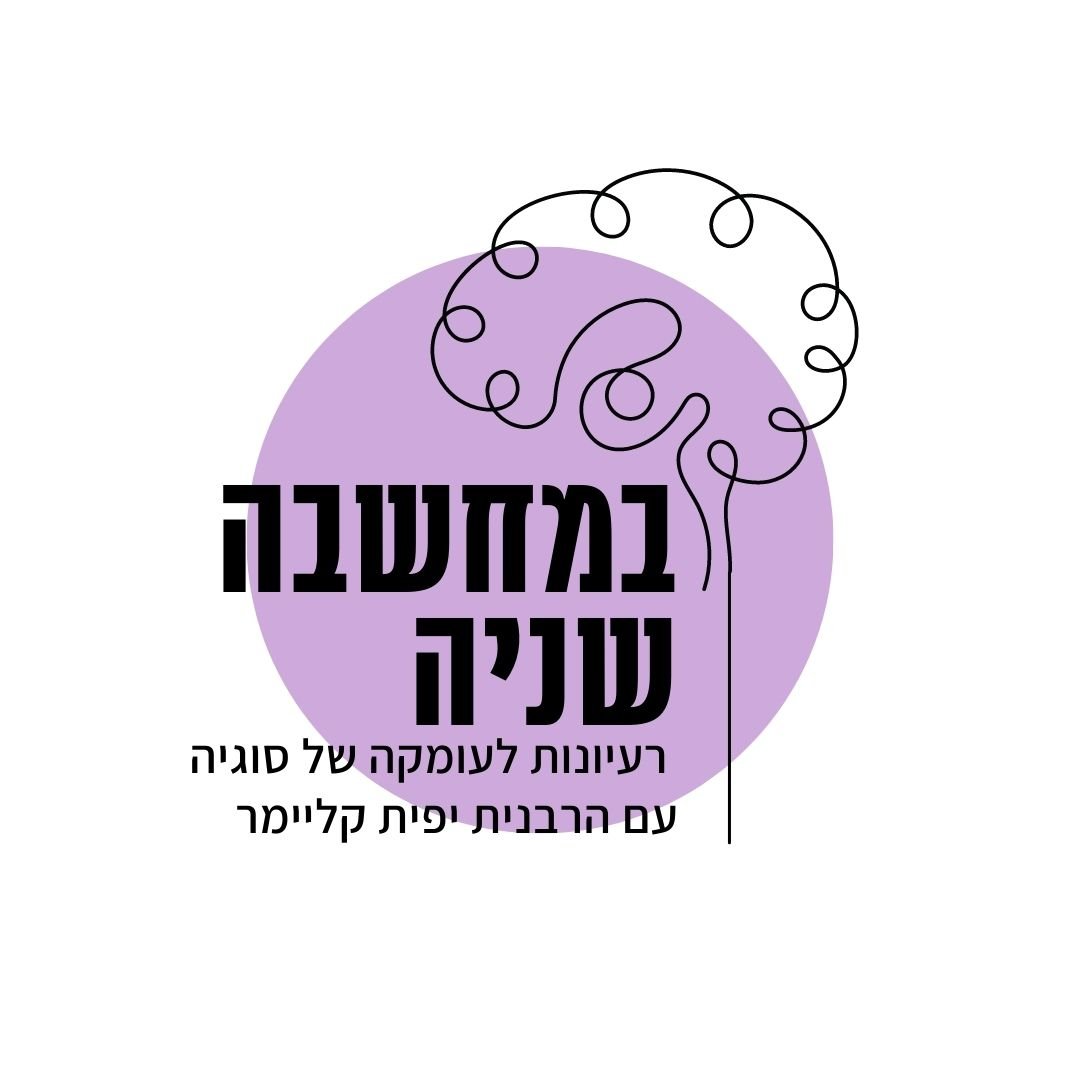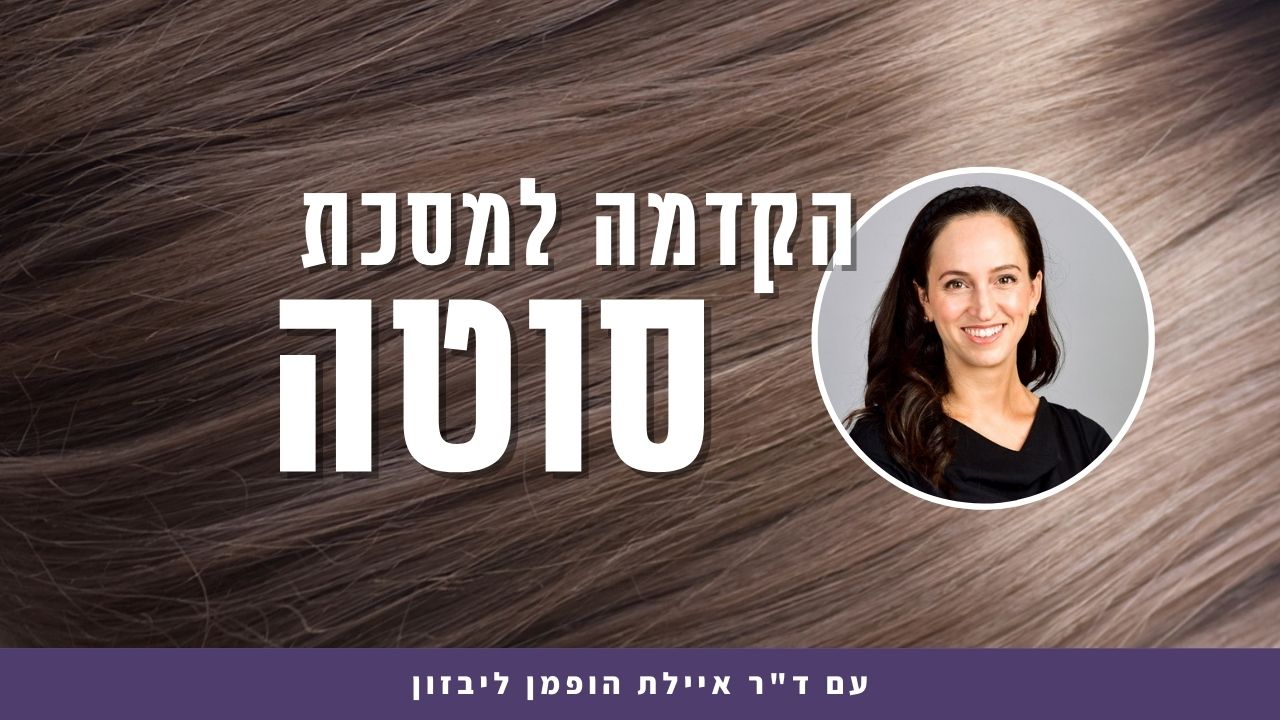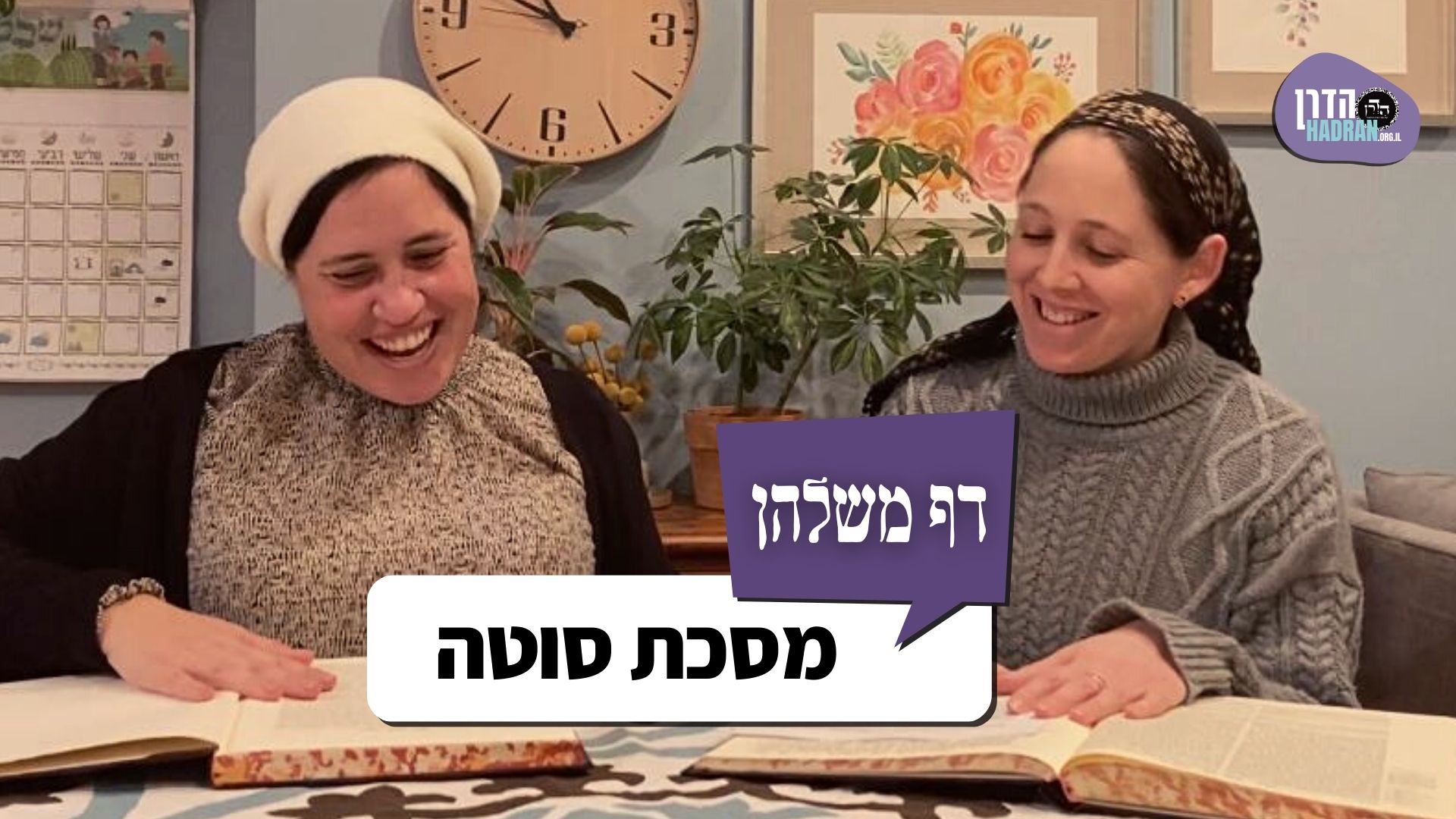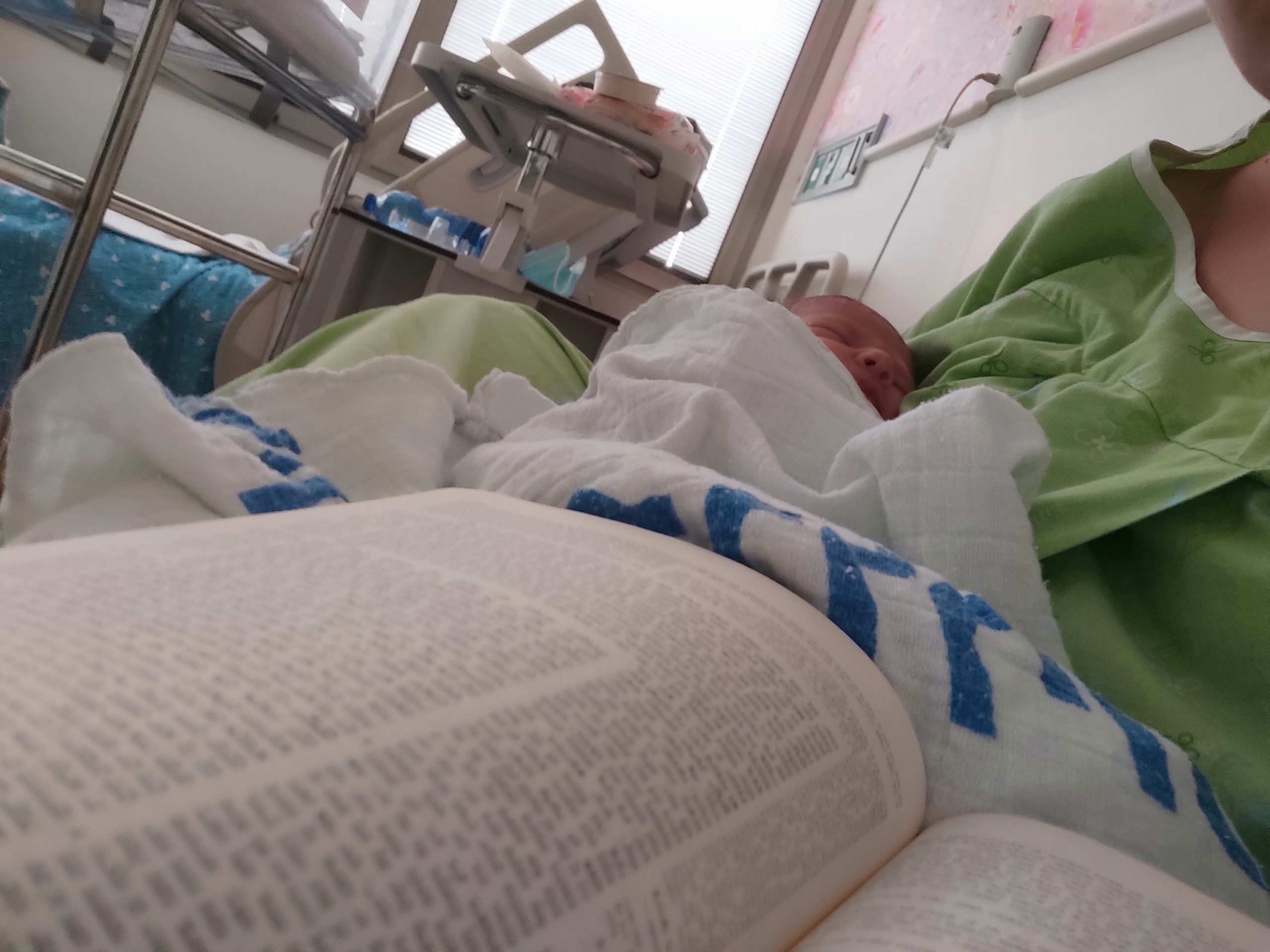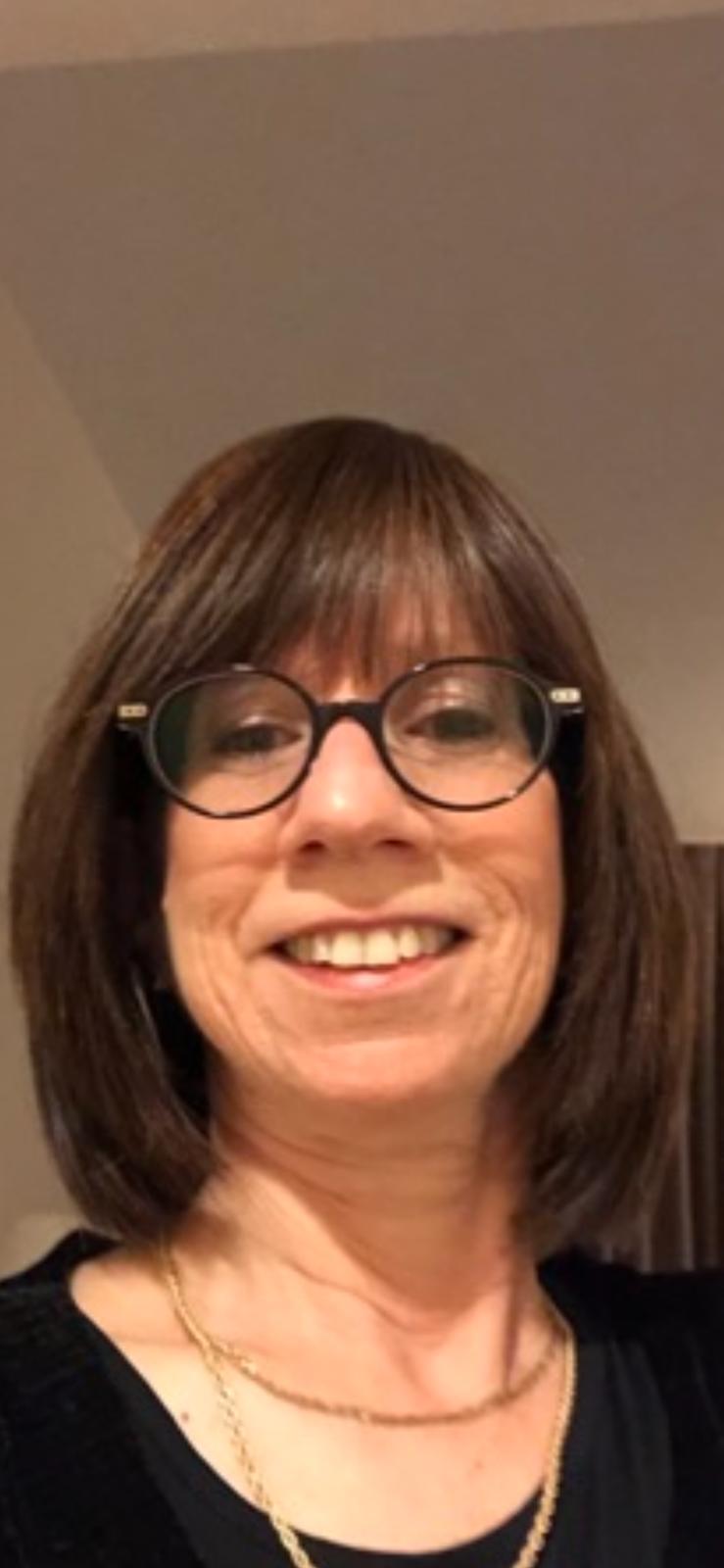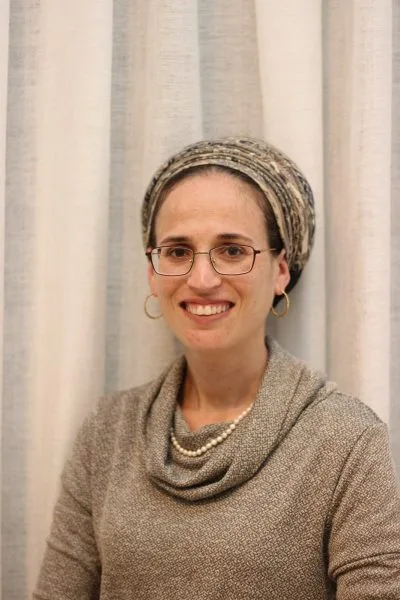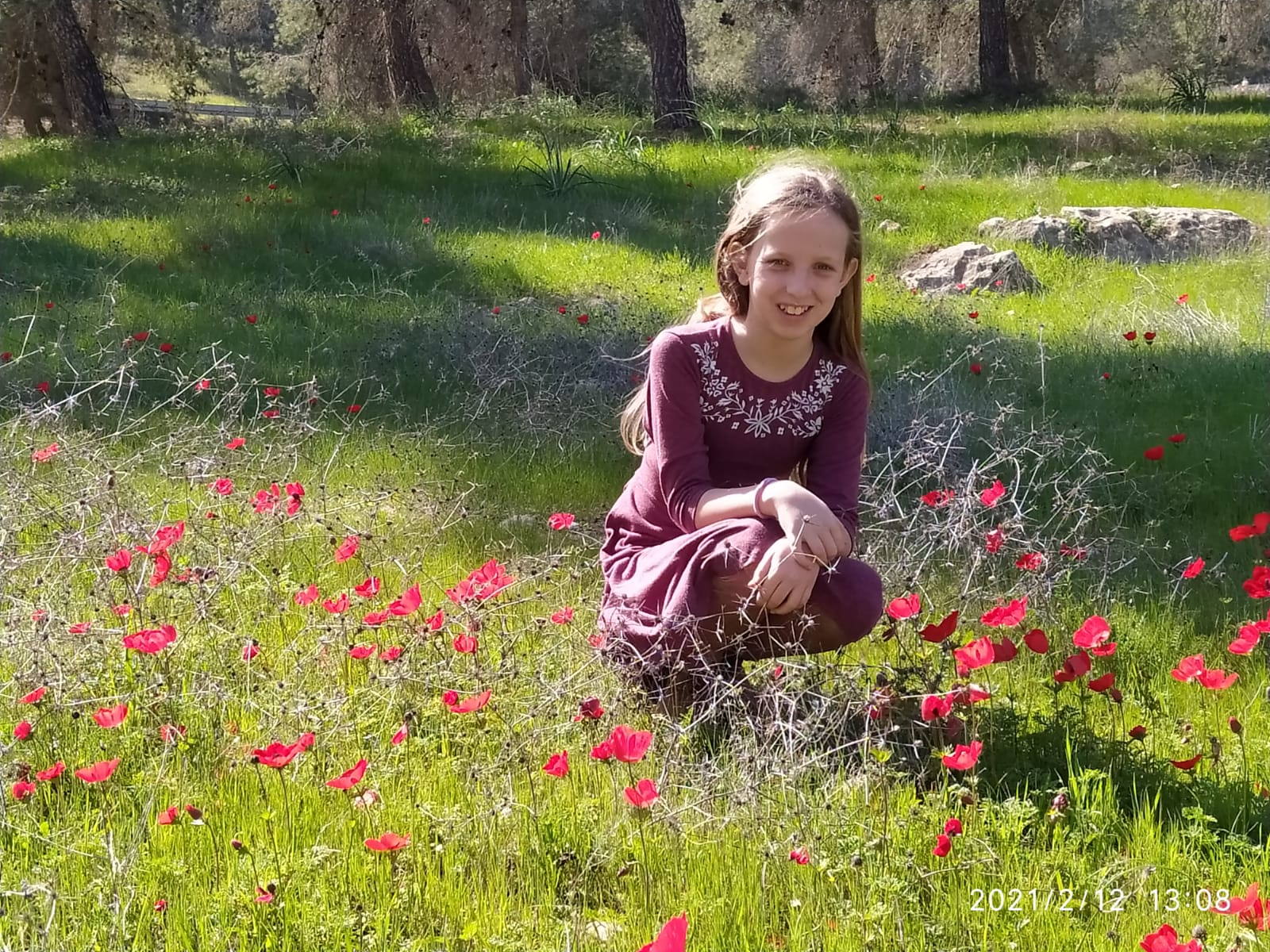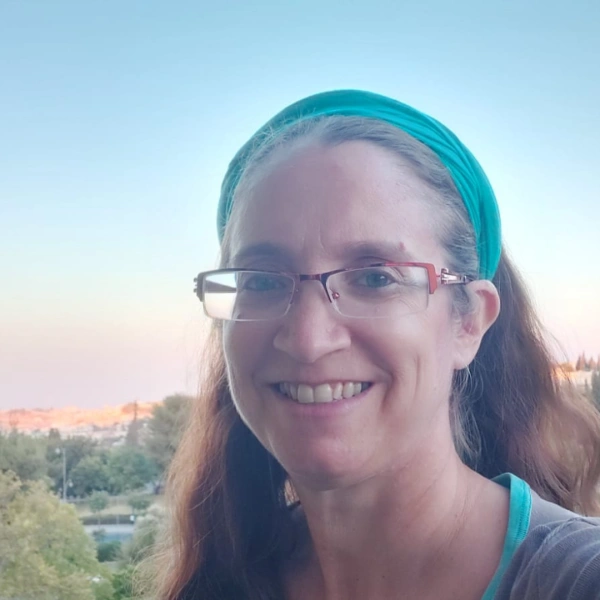סוטה מו
וְהַכֹּהֲנִים אוֹמְרִים: ״כַּפֵּר לְעַמְּךָ יִשְׂרָאֵל אֲשֶׁר פָּדִיתָ ה׳ וְאַל תִּתֵּן דָּם נָקִי בְּקֶרֶב עַמְּךָ יִשְׂרָאֵל״. לֹא הָיוּ צְרִיכִין לוֹמַר ״וְנִכַּפֵּר לָהֶם הַדָּם״, אֶלָּא רוּחַ הַקּוֹדֶשׁ מְבַשַּׂרְתָּן: אֵימָתַי שֶׁתַּעֲשׂוּ כָּכָה — הַדָּם מִתְכַּפֵּר לָהֶם.
And the priests recite: “Forgive, Lord, Your people Israel, whom You have redeemed, and suffer not innocent blood to remain in the midst of Your people Israel” (Deuteronomy 21:8). They did not have to recite the conclusion of the verse: “And the blood shall be forgiven for them,” as this is not part of the priests’ statement, but rather the Divine Spirit informs them: When you shall do so, the blood is forgiven for you.
גְּמָ׳ וִיהֵא מוּם פּוֹסֵל בְּעֶגְלָה מִקַּל וָחוֹמֶר: וּמָה פָּרָה שֶׁאֵין הַשָּׁנִים פּוֹסְלוֹת בָּהּ, מוּם פּוֹסֵל בָּהּ, עֶגְלָה שֶׁשָּׁנִים פּוֹסְלוֹת בָּהּ — אֵינוֹ דִּין שֶׁיְּהֵא מוּם פּוֹסֵל בָּהּ! שָׁאנֵי הָתָם דְּאָמַר קְרָא: ״אֲשֶׁר אֵין בָּהּ מוּם״ — בָּהּ מוּם פּוֹסֵל, וְאֵין מוּם פּוֹסֵל בְּעֶגְלָה.
GEMARA: With regard to the mishna’s statement that the heifer is not disqualified by a blemish, the Gemara suggests: And a blemish should disqualify in the case of the heifer, by means of an a fortiori inference: And if in the case of the red heifer, which is not disqualified by years, as it may be of any age, and yet a blemish disqualifies it, then a heifer for this ritual, which is disqualified by years, as it is valid only until two years of age, is it not logical that a blemish should disqualify it? The Gemara answers: It is different there, in the case of the red heifer, as the verse states: “Wherein [bah] has no blemish” (Numbers 19:2). This serves as an exclusion and teaches that it is only with regard to it [bah] that a blemish is disqualifying, but a blemish is not disqualifying with regard to the heifer of the ritual of the breaking of the neck.
אֶלָּא מֵעַתָּה לֹא יְהוּ שְׁאָר עֲבוֹדוֹת פּוֹסְלוֹת בָּהּ.
The Gemara asks: However, if that is so, if the word “bah” precludes a derivation by an a fortiori inference, then any other labor performed with the red heifer, apart from pulling a yoke, should not disqualify it. While the verse disqualifies a red heifer only if it pulled a yoke, as it states: “And upon which never came a yoke” (Numbers 19:2), a similar a fortiori inference could be learned from the heifer whose neck is to be broken to disqualify a red heifer that has performed any labor. However, since the verse states with regard to the heifer whose neck is to be broken: “That has not been worked with [bah]” (Deuteronomy 21:3), this indicates that labor is disqualifying only for “bah,” a heifer whose neck is to be broken, but not for a red heifer.
אַלְּמָה אָמַר רַב יְהוּדָה אָמַר רַב: הִנִּיחַ עָלֶיהָ עוּדָּה שֶׁל שַׂקִּין — פְּסוּלָה, וּבְעֶגְלָה עַד שֶׁתִּמְשׁוֹךְ! שָׁאנֵי פָּרָה, דְּיָלְפִינַן ״עֹל״ ״עֹל״ מֵעֶגְלָה.
Why, then, does Rav Yehuda say that Rav says: If he placed a bundle [uda] of sacks on a red heifer, the heifer is immediately disqualified from being used as the red heifer; and as for the heifer whose neck is broken, it is not disqualified by such labor until it pulls and moves the burden, as the verse states: “That has not pulled a yoke” (Deuteronomy 21:3). Why does bearing the weight of the bundle disqualify the red heifer? The Gemara explains: The halakha with regard to the red heifer is different, as we learn by a verbal analogy between the word “yoke” used with regard to the red heifer and the word “yoke” used with regard to the heifer whose neck is broken that any labor disqualifies the former.
עֶגְלָה נָמֵי תֵּיתֵי ״עֹל״ ״עֹל״ מִפָּרָה! הָא מַיעֵט רַחֲמָנָא ״בָּהּ״.
The Gemara raises an objection: If there is a verbal analogy between the red heifer and the heifer that will have its neck broken, then the halakha that a blemish should disqualify the heifer whose neck is broken should also be derived from the usage of “yoke” with regard to the heifer whose neck is broken and from the usage of “yoke” with regard to the red heifer. The Gemara answers: The Merciful One has excluded this possibility by placing in the verse the word “bah,” which indicates that disqualification due to blemish applies only to the red heifer and not to the heifer whose neck is broken.
בְּעֶגְלָה נָמֵי כְּתִיב ״בָּהּ״! הָהוּא מִיבְּעֵי לֵיהּ לְמַעוֹטֵי קֳדָשִׁים, דְּלָא פָּסְלָה בְּהוּ עֲבוֹדָה. סָלְקָא דַּעְתָּךְ אָמֵינָא לֵיתֵי בְּקַל וָחוֹמֶר מֵעֶגְלָה: וּמָה עֶגְלָה שֶׁאֵין מוּם פּוֹסֵל בָּהּ — עֲבוֹדָה פּוֹסֶלֶת בָּהּ, קֳדָשִׁים שֶׁמּוּם פּוֹסֵל(ת) בָּהֶן — אֵינוֹ דִּין שֶׁעֲבוֹדָה פּוֹסֶלֶת בָּהֶן?
The Gemara counters this claim: In the verse concerning a heifer whose neck is broken, the Torah also writes “bah”; it should be the case that forms of labor other than pulling a yoke are disqualifying only with regard to it and not with regard to the red heifer. The Gemara answers: That word “bah” is required by Rav Yehuda in order to exclude sacred offerings, i.e., which are not disqualified by labor, and one may bring an animal that has been used for labor as an offering. It might enter your mind to say that this should be derived by an a fortiori inference from a heifer whose neck is broken, as follows: And if with regard to a heifer whose neck is broken, which is not disqualified by a blemish, labor nevertheless disqualifies it, then with regard to sacred offerings, which are disqualified by a blemish, is it not right that labor should disqualify them? In order to counter this argument, the word “bah” teaches us that a sacred offering is not disqualified by labor.
אִיכָּא לְמִיפְרַךְ: מָה לְעֶגְלָה שֶׁכֵּן שָׁנִים פּוֹסְלוֹת בָּהּ! אַטּוּ קֳדָשִׁים מִי לֵיכָּא דְּפָסְלִי בְּהוּ שָׁנִים? כִּי אִיצְטְרִיךְ קְרָא לְהָנָךְ קֳדָשִׁים דְּפָסְלִי בְּהוּ שָׁנִים.
With regard to this suggested a fortiori inference, the Gemara observes that it can be refuted in the following manner: What about the fact that a heifer whose neck is broken is disqualified by years, as once it reaches two years of age it is no longer classified as a heifer? As it is clear that the heifer whose neck is to be broken carries some restrictions that do not apply to sacred offerings, perhaps being disqualified by labor is another such restriction. The Gemara refutes this argument: Is that to say that there are no sacred offerings that are disqualified by years? There are several offerings that may be brought only in their first or second year, and where the verse is necessary to teach that sacred offerings are not disqualified by labor, it is with regard to those sacred offerings that are disqualified by years.
וְקָדָשִׁים דְּלָא פָּסְלָה בְּהוּ עֲבוֹדָה מֵהָכָא נָפְקָא? מֵהָתָם נָפְקָא: ״עַוֶּרֶת אוֹ שָׁבוּר אוֹ חָרוּץ אוֹ יַבֶּלֶת אוֹ גָרָב אוֹ יַלֶּפֶת לֹא תַקְרִיבוּ אֵלֶּה לַה׳״, אֵלֶּה אִי אַתָּה מַקְרִיב, אֲבָל אַתָּה מַקְרִיב קֳדָשִׁים שֶׁנֶּעֶבְדָה בָּהֶן עֲבוֹדָה! אִיצְטְרִיךְ, סָלְקָא דַּעְתָּךְ אָמֵינָא: הָנֵי מִילֵּי הֵיכָא דְּעָבַד בָּהֶן עֲבוֹדַת הֶיתֵּר, אֲבָל עֲבוֹדַת אִיסּוּר אֵימָא לִיתַּסְרוּ, צְרִיכָא.
The Gemara raises an objection: But is the halakha that sacred offerings are not disqualified by labor derived from this verse? It is derived from elsewhere. The verse states with regard to sacred offerings: “Blind, or broken, or maimed, or having a wart, or scabbed, or scurvy, you shall not offer these to the Lord” (Leviticus 22:22). This verse serves to create an exclusion, teaching that it is these that you may not sacrifice, but you may sacrifice sacred animals that have been used for labor. The Gemara answers: It was necessary to state the halakha twice. It might enter your mind to say that this halakha, that one may sacrifice animals that have been used for labor, applies only in a case where they were used for permitted labor, but if they were used for prohibited labor, e.g., on Shabbat, you might say that it is prohibited to bring them as offerings. In order to refute this argument, it is necessary to state the halakha again.
וְהָא נָמֵי מֵהָכָא נָפְקָא — ״וּמִיַּד בֶּן נֵכָר לֹא תַקְרִיבוּ אֶת לֶחֶם אֱלֹהֵיכֶם מִכׇּל אֵלֶּה״, אֵלֶּה אִי אַתָּה מַקְרִיב, אֲבָל אַתָּה מַקְרִיב קֳדָשִׁים שֶׁנֶּעֶבְדָה בָּהֶן עֲבוֹדָה!
The Gemara poses another question: But this halakha that prohibited labor does not disqualify offerings is also derived from here, a verse with regard to the sacrifice of blemished animals: “And from the hand of a stranger you shall not offer the bread of your God from any of these, because…there is a blemish in them” (Leviticus 22:25). This verse emphasizes that it is only “these,” i.e., blemished animals, that you may not sacrifice, but you may sacrifice sacred animals that have been used for labor. Since this verse is discussing the possibility of accepting offerings from a gentile, who presumably also performed prohibited labor with the animal, this demonstrates that prohibited labor does not disqualify animals from being sacrificed as offerings.
אִיצְטְרִיךְ, סָלְקָא דַּעְתָּךְ אָמֵינָא: הָנֵי מִילֵּי הֵיכָא דְּעָבַד בָּהֶן כְּשֶׁהֵן חוּלִּין, אֲבָל עָבַד בָּהֶן כְּשֶׁהֵן קֳדָשִׁים — אֵימָא לִיתַּסְרוּ, צְרִיכָא.
The Gemara answers: It was necessary to teach this halakha a third time. It might enter your mind to say: This halakha, that labor does not disqualify offerings, applies only where one performed labor with them when they were non-sacred and afterward dedicated them as offerings, but if one performed labor with them when they were already sacred animals, you might say that it is prohibited to bring them as offerings. In order to refute this argument, it is necessary to teach this halakha in three separate places.
גּוּפָא, אָמַר רַב יְהוּדָה אָמַר רַב: הִנִּיחַ עָלֶיהָ עוּדָּה שֶׁל שַׂקִּין פְּסוּלָה, וּבְעֶגְלָה עַד שֶׁתִּמְשׁוֹךְ. מֵיתִיבִי: ״עֹל״, אֵין לִי אֶלָּא עוֹל, שְׁאָר עֲבוֹדוֹת מִנַּיִן? אָמַרְתָּ, קַל וָחוֹמֶר: וּמָה עֶגְלָה שֶׁאֵין מוּם פּוֹסֵל בָּהּ, שְׁאָר עֲבוֹדוֹת פּוֹסְלוֹת בָּהּ, פָּרָה שֶׁמּוּם פּוֹסֵל בָּהּ — אֵינוֹ דִּין שֶׁשְּׁאָר עֲבוֹדוֹת פּוֹסְלִין בָּהּ?
§ The Gemara returns to discuss the matter itself: Rav Yehuda says that Rav says: If one placed a bundle of sacks on a red heifer, it is disqualified. And as for a heifer whose neck is broken, it is not disqualified until it pulls a burden. The Gemara raises an objection from a baraita: It states with regard to the red heifer: “That upon which never came a yoke” (Numbers 19:2). I have derived only a yoke; from where do I derive that other types of labor also disqualify the animal? You can say the following a fortiori inference: And if with regard to a heifer whose neck is broken, which is not disqualified by a blemish, other types of labor disqualify it, then with regard to a red heifer, which is disqualified by a blemish, is it not right that other types of labor should disqualify it?
וְאִם נַפְשְׁךָ לוֹמַר: נֶאֱמַר כָּאן ״עֹל״ וְנֶאֱמַר לְהַלָּן ״עֹל״. מָה לְהַלָּן שְׁאָר עֲבוֹדוֹת פּוֹסְלוֹת בָּהּ — אַף כָּאן שְׁאָר עֲבוֹדוֹת פּוֹסְלוֹת.
And if it is your wish to say that this a fortiori inference is unsound, you can learn this halakha by a verbal analogy: It is stated here, with regard to the red heifer, “yoke” (Numbers 19:2), and it is stated there, with regard to the heifer whose neck is broken, “yoke” (Deuteronomy 21:3). Just as there, other types of labor disqualify it, so too here, in the case of the red heifer, other types of labor disqualify it.
מַאי ״אִם נַפְשְׁךָ לוֹמַר״? וְכִי תֵּימָא, אִיכָּא לְמִיפְרַךְ: מָה לְעֶגְלָה שֶׁכֵּן שָׁנִים פּוֹסְלוֹת בָּהּ. אִי נָמֵי: קֳדָשִׁים יוֹכִיחוּ, שֶׁמּוּם פּוֹסֵל בָּהֶן, וְאֵין עֲבוֹדָה פּוֹסֶלֶת בָּהֶן.
The Gemara asks: What is the meaning of: If it is your wish to say? What potential problem with the a fortiori inference necessitates the verbal analogy? The Gemara explains: And perhaps you would say that the a fortiori inference can be refuted in the following manner: What is unique about a heifer whose neck is broken is that it is disqualified by years, which is not the case for a red heifer. Alternatively, one could suggest that sacred offerings will prove that this inference should not be made, as a blemish is disqualifying with regard to them, but labor is not disqualifying with regard to them.
נֶאֱמַר כָּאן ״עֹל״ וְנֶאֱמַר לְהַלָּן ״עֹל״, מָה לְהַלָּן שְׁאָר עֲבוֹדוֹת — אַף כָּאן שְׁאָר עֲבוֹדוֹת. וּמִמָּקוֹם שֶׁבָּאתָה: מָה לְהַלָּן עַד שֶׁתִּמְשׁוֹךְ, אַף כָּאן עַד שֶׁתִּמְשׁוֹךְ!
As the a fortiori inference can be refuted in either of these ways, there is a need for the verbal analogy: It is stated here “yoke,” and it is stated there “yoke.” Just as there, in the case of a heifer whose neck is broken, other types of labor disqualify it, so too, other types of labor disqualify a red heifer. The Gemara raises an objection to this verbal analogy: And from the place that you came you can offer an alternative exposition: Just as below, in the case of a heifer whose neck is broken, it is not disqualified by carrying a burden until it pulls the yoke, so too here, a red heifer should not be disqualified until it pulls the yoke, contrary to the statement of Rav.
תַּנָּאֵי הִיא, דְּאִיכָּא דְּמַיְיתֵי לַהּ מֵעֶגְלָה, אִיכָּא דְּמַיְיתֵי לַהּ מִגּוּפַהּ דְּפָרָה.
The Gemara answers the objection to the statement of Rav from the baraita: It is a dispute among tanna’im, as there are those who cite the source of this halakha, that labor disqualifies a red heifer, by verbal analogy from a heifer whose neck is broken, and therefore the red heifer is disqualified only if it pulls the burden. There are also those who cite the source of this halakha from a red heifer itself, and consequently they disqualify the red heifer even if it did not pull the yoke.
דְּתַנְיָא: ״עֹל״, אֵין לִי אֶלָּא עוֹל. שְׁאָר עֲבוֹדוֹת מִנַּיִן — תַּלְמוּד לוֹמַר: ״אֲשֶׁר לֹא עָלָה עָלֶיהָ עֹל״ מִכׇּל מָקוֹם. אִם כֵּן מָה תַּלְמוּד לוֹמַר ״עֹל״ — עוֹל פּוֹסֵל בֵּין בִּשְׁעַת עֲבוֹדָה בֵּין שֶׁלֹּא בִּשְׁעַת עֲבוֹדָה, שְׁאָר עֲבוֹדוֹת אֵין פּוֹסְלוֹת אֶלָּא בִּשְׁעַת עֲבוֹדָה.
This is as it is taught in a baraita with regard to a red heifer: From the term “yoke” I have derived only that a yoke disqualifies a red heifer; from where do I derive the other types of labor? The verse states: “That upon which never came a yoke” (Numbers 19:2). The verse could be read with a pause after the word “came,” which would teach that it is disqualified in any case, no matter what labor was performed with it. If so, what is the meaning when the verse states “yoke,” if all forms of labor disqualify it? It teaches us that a yoke placed on the animal disqualifies it whether the yoke was on the animal at the time of performing labor or whether it was on the animal not at the time of performing labor, i.e., it was merely placed on the animal. However, other types of labor actions disqualify animals only at the time of actually performing labor. Rav ruled in accordance with this opinion.
וְאֵימָא: ״אֲשֶׁר לֹא עָלָה עָלֶיהָ״ — כָּלַל, ״עֹל״ — פָּרַט, כְּלָל וּפְרָט, אֵין בַּכְּלָל אֶלָּא מָה שֶׁבַּפְּרָט: עוֹל אִין, מִידֵּי אַחֲרִינָא — לָא! ״אֲשֶׁר״ — רִבּוּיָא הוּא.
The Gemara raises an objection: And perhaps one can say a different exposition of the verse: “That upon which never came” is a generalization that disqualifies the animal after any type of labor, while “yoke” is a detail. There is a generalization and a detail, and the principle of halakhic exposition in that case is that there is nothing in the generalization other than what is in the detail. Therefore, with regard to a yoke, yes, it will disqualify an animal from being used as a red heifer; but with regard to anything else, no, it will not disqualify the animal. The Gemara answers: “That upon which never came” is an amplification, and the addition of this term results in this verse not belonging to the category of generalizations and details.
וְתַנְיָא נָמֵי גַּבֵּי עֶגְלָה כִּי הַאי גַוְונָא: ״עֹל״, אֵין לִי אֶלָּא עוֹל. שְׁאָר עֲבוֹדוֹת מִנַּיִן — תַּלְמוּד לוֹמַר: ״אֲשֶׁר לֹא עֻבַּד בָּהּ״ מִכׇּל מָקוֹם. אִם כֵּן מָה תַּלְמוּד לוֹמַר ״עֹל״ — עוֹל פּוֹסֵל בֵּין בִּשְׁעַת עֲבוֹדָה בֵּין שֶׁלֹּא בִּשְׁעַת עֲבוֹדָה, שְׁאָר עֲבוֹדוֹת אֵין פּוֹסְלוֹת אֶלָּא בִּשְׁעַת עֲבוֹדָה.
The Gemara comments: And a case like this is also taught in a baraita with regard to a heifer whose neck is broken: From the word “yoke” I have derived only that a yoke disqualifies; from where do I derive the other types of labor? The same verse states: “That has not been worked with” (Deuteronomy 21:3), to teach that it is disqualified in any case, no matter what labor was performed with it. If so, what is the meaning when the verse states “yoke”? It serves to teach us that a yoke placed on the animal disqualifies it whether the yoke was on the animal at the time of performing labor or whether it was on the animal not at the time of performing labor, i.e., it was merely placed on the animal, whereas other types of labor actions disqualify animals only at the time of actually performing labor.
וְאֵימָא: ״אֲשֶׁר לֹא עֻבַּד בָּהּ״ — כָּלַל, ״עֹל״ — פָּרַט. כְּלָל וּפְרָט, אֵין בַּכְּלָל אֶלָּא מָה שֶׁבַּפְּרָט: עוֹל — אִין, מִידֵּי אַחֲרִינָא — לָא! ״אֲשֶׁר״ — רִבּוּיָא הוּא.
The Gemara raises an objection: And perhaps one can say a different exposition of the verse: “That has not been worked with” is a generalization that disqualifies the animal after any type of labor, while “yoke” is a detail. There is a generalization and a detail, and the principle of halakhic exposition in that case is that there is nothing in the generalization other than what is in the detail, which means: With regard to a yoke, yes, it will disqualify an animal, but with regard to anything else, no, it will not disqualify it. The Gemara answers: The phrase “that has not been worked with” is an amplification, and the addition of this term results in this verse not belonging to the category of generalizations and details.
אָמַר רַבִּי אֲבָהוּ, בְּעַי מִינֵּיהּ מֵרַבִּי יוֹחָנָן: מְשִׁיכַת עוֹל בְּכַמָּה? אָמַר לִי: כִּמְלֹא עוֹל. אִיבַּעְיָא לְהוּ: לְאׇרְכּוֹ אוֹ לְרׇחְבּוֹ? אֲמַר לְהוּ הַהוּא מֵרַבָּנַן וְרַבִּי יַעֲקֹב שְׁמֵיהּ: לְדִידִי מִפָּרְשָׁא לִי מִינֵּיהּ דְּרַבִּי יוֹחָנָן: מְשִׁיכַת עוֹל לְרׇחְבּוֹ טֶפַח.
Rabbi Abbahu said: I asked of Rabbi Yoḥanan: This pulling of a yoke that disqualifies a heifer whose neck is broken, with how much, i.e., how far, must the animal pull the yoke for it to be disqualified? He said to me: Like the measure of the size of a full yoke. A dilemma was raised before the Sages: Does this mean according to its length or according to its width? One of the Sages, and Rabbi Ya’akov was his name, said to them: It was explained to me personally by Rabbi Yoḥanan himself: The pulling of a yoke is according to its width, which is a handbreadth.
וְלֵימָא טֶפַח? הָא קָא מַשְׁמַע לַן שִׁיעוּרָא דְּעוֹל — טֶפַח הָוֵי. לְמַאי נָפְקָא מִינַּהּ — לְמִקָּח וּמִמְכָּר.
The Gemara poses a question: And since he stated a fixed measurement, let him merely state: A handbreadth. Why was it necessary to add that this is the width of a yoke? The Gemara answers: This teaches us that the measure of a yoke along its width is a handbreadth. What difference is there in knowing this fact? This teaches that in the case of commercial transactions, a buyer may retract his purchase if the yoke he was given is less than a handbreadth wide.
אָמַר רַבִּי יוֹחָנָן בֶּן שָׁאוּל, מִפְּנֵי מָה אָמְרָה תּוֹרָה: הָבֵיא עֶגְלָה בְּנַחַל? אָמַר הַקָּדוֹשׁ בָּרוּךְ הוּא: יָבֹא דָּבָר שֶׁלֹּא עָשָׂה פֵּירוֹת, וְיֵעָרֵף בִּמְקוֹם שֶׁאֵין עוֹשֶׂה פֵּירוֹת, וִיכַפֵּר עַל מִי שֶׁלֹּא הִנִּיחוּ[הוּ] לַעֲשׂוֹת פֵּירוֹת. מַאי פֵּירוֹת? אִילֵימָא פְּרִיָּה וּרְבִיָּה — אֶלָּא מֵעַתָּה אַזָּקֵן וְאַסָּרִיס הָכִי נָמֵי דְּלָא עָרְפִינַן?! אֶלָּא מִצְוֹת.
Rabbi Yoḥanan ben Shaul says: For what reason did the Torah say to bring a heifer whose neck is broken to a stream? The Holy One, Blessed be He, said: Let something that did not produce fruit, i.e., a heifer that has not given birth, come and have its neck be broken at a stream that flows forcefully, which is a place that does not produce fruit, and atone for the murder of one who was not given an opportunity to produce fruit. The Gemara asks: What is this fruit that he was not given an opportunity to produce? If we say it refers to being fruitful and multiplying, i.e., that the killer prevented him from having more children, but if that is so, in the case of an elderly person or a eunuch, so too will you say that we do not break the heifer’s neck because they could not have had any more children even had they lived? Rather, the fruit are mitzvot, as the killer deprived the victim of the opportunity to perform additional mitzvot.
וּמוֹרִידִין אוֹתָהּ אֶל נַחַל אֵיתָן. ״אֵיתָן״ כְּמַשְׁמָעוֹ, קָשֶׁה. תָּנוּ רַבָּנַן: מִנַּיִן לְאֵיתָן שֶׁהוּא קָשֶׁה — שֶׁנֶּאֱמַר:
The mishna taught: And they bring it down to a stream that is eitan. Eitan in this context means as the word generally indicates, forceful. The Sages taught: From where is it derived that eitan is forceful? It is as it is stated:
״אֵיתָן מוֹשָׁבֶךָ וְשִׂים בַּסֶּלַע קִנֶּךָ״, וְאוֹמֵר: ״שִׁמְעוּ הָרִים אֶת רִיב ה׳ וְהָאֵיתָנִים מֹסְדֵי אָרֶץ״. אֲחֵרִים אוֹמְרִים: מִנַּיִן לְ״אֵיתָן״ שֶׁהוּא יָשָׁן — שֶׁנֶּאֱמַר: ״גּוֹי אֵיתָן הוּא, גּוֹי מֵעוֹלָם הוּא״.
“Firm [eitan] is your dwelling-place, and your nest is set in the rock” (Numbers 24:21), and it states: “Hear, O you mountains, the Lord’s controversy, and the enduring rocks [eitanim], the foundations of the earth” (Micah 6:2). The use of the word in these verses indicates that “eitan” means something hard, like a rock or a mountain. Others say a different explanation of the word eitan: From where is it derived that eitan means old? As it is stated: “It is an ancient [eitan] nation, a nation from of old” (Jeremiah 5:15).
״וְעוֹרְפִין אוֹתָהּ בְּקוֹפִיץ מֵאֲחוֹרֶיהָ״. מַאי טַעְמָא — גָּמַר עֲרִיפָה עֲרִיפָה מֵחַטַּאת הָעוֹף.
§ The mishna taught: And they break the neck [orfin] of the heifer from behind with a cleaver. The Gemara explains: What is the reason that the Sages understood that the heifer is killed in this manner? They derive that the term arifa, which describes what is done to the heifer, refers to breaking the back of the neck, from the term arifa stated with regard to the bird brought as a sin-offering (see Leviticus 5:8).
״וּמְקוֹמָהּ, אָסוּר מִלִּזְרוֹעַ וּמִלֵּיעָבֵד״. תָּנוּ רַבָּנַן: ״אֲשֶׁר לֹא יֵעָבֵד בּוֹ וְלֹא יִזָּרֵעַ״ — לְשֶׁעָבַר, דִּבְרֵי רַבִּי יֹאשִׁיָּה. רַבִּי יוֹנָתָן אוֹמֵר: לְהַבָּא.
§ The mishna taught further: And with regard to its place, it is prohibited for that ground to be sown or to be worked. The Sages taught: The verse: “Which may be neither worked nor sown” (Deuteronomy 21:4) is referring to the past, that is, a place which has not previously been worked or sown. This is the statement of Rabbi Yoshiya. Rabbi Yonatan says: It speaks of the future, meaning it is prohibited to sow or work the land from that point onward.
רָבָא אָמַר: לְהַבָּא — דְּכוּלֵּי עָלְמָא לָא פְּלִיגִי, דִּכְתִיב: ״וְלֹא יִזָּרֵעַ״, כִּי פְּלִיגִי לְשֶׁעָבַר. רַבִּי יֹאשִׁיָּה סָבַר: מִי כְּתִיב ״וְלֹא יְעוּבַּד״? וְרַבִּי יוֹנָתָן: מִי כְּתִיב ״אֲשֶׁר לֹא נֶעֱבַד״? וְרַבִּי יֹאשִׁיָּה: ״אֲשֶׁר״ — לְשֶׁעָבַר מַשְׁמַע, וְרַבִּי יוֹנָתָן: ״אֲשֶׁר״ — רִבּוּיָא הוּא.
Rava said: As for the future, everyone agrees that it is prohibited to sow or work the land, as it is written “neither worked nor sown” in the future tense. When they disagree is with regard to the past. Rabbi Yoshiya, who disqualifies a place that was sown beforehand, holds: Does it state: And shall not be worked, in the form of a future command? And Rabbi Yonatan responds: Does it state: And was not worked, in the past tense? And Rabbi Yoshiya answers: The term “which” indicates the past. And as for Rabbi Yonatan, in his opinion the term “which” is a term of amplification, as will be explained later in the Gemara, and it is not referring to the past.
וּמוּתָּר לִסְרוֹק שָׁם פִּשְׁתָּן וּלְנַקֵּר שָׁם אֲבָנִים. תָּנוּ רַבָּנַן: ״אֲשֶׁר לֹא יֵעָבֵד בּוֹ וְלֹא יִזָּרֵעַ״ — אֵין לִי אֶלָּא זְרִיעָה, שְׁאָר עֲבוֹדוֹת מִנַּיִן? תַּלְמוּד לוֹמַר: ״אֲשֶׁר לֹא יֵעָבֵד בּוֹ״ — מִכׇּל מָקוֹם.
§ The mishna taught: But it is permitted to comb flax there or to cut stones there. The Sages taught: From the phrase “which may be neither worked nor sown,” I have derived only sowing; from where do I derive that other types of labor are also prohibited? The verse states: “Which may be neither worked,” indicating that it may not be worked in any manner.
אִם כֵּן מָה תַּלְמוּד לוֹמַר ״וְלֹא יִזָּרֵעַ״? לוֹמַר לְךָ: מָה זְרִיעָה מְיוּחֶדֶת שֶׁהִיא בְּגוּפָהּ שֶׁל קַרְקַע, אַף כֹּל שֶׁהוּא בְּגוּפָהּ שֶׁל קַרְקַע. יָצָא סְרִיקַת פִּשְׁתָּן וְנִיקּוּר אֲבָנִים, שֶׁאֵינָן בְּגוּפָהּ שֶׁל קַרְקַע.
The baraita continues: If so, why does the verse also need to state “nor sown”? It is in order to say to you: Just as sowing is unique in that it is labor performed on the land itself, so too, all labor that is performed on the land itself is prohibited. This excludes combing flax and cutting stones, which are not done on the land itself.
וְאֵימָא: ״אֲשֶׁר לֹא יֵעָבֵד בּוֹ״ — כָּלַל, ״וְלֹא יִזָּרֵעַ״ — פָּרַט. כְּלָל וּפְרָט, אֵין בַּכְּלָל אֶלָּא מָה שֶׁבַּפְּרָט: זְרִיעָה — אִין, מִידֵּי אַחֲרִינָא — לָא! ״אֲשֶׁר״ — רִבּוּיָא הוּא.
The Gemara raises an objection: And perhaps one can say a different exposition: “Which may be neither worked” is a generalization, and “nor sown” a detail. When the Torah writes a generalization and a detail, there is nothing in the generalization other than what is in the detail, i.e., the detail serves to impose a limit on the generalization. Consequently, the verse is teaching that with regard to sowing, yes, it is prohibited, but with regard to anything else, no, it is not prohibited. The Gemara again answers: The term “which” is an amplification, and the addition of this term results in this verse not belonging to the category of generalizations and details.
זִקְנֵי הָעִיר רוֹחֲצִין יְדֵיהֶן כּוּ׳. תָּנוּ רַבָּנַן: ״וְכׇל זִקְנֵי הָעִיר הָהִיא הַקְּרֹבִים אֶל הֶחָלָל יִרְחֲצוּ אֶת יְדֵיהֶם עַל הָעֶגְלָה הָעֲרוּפָה בַנָּחַל״. שֶׁאֵין תַּלְמוּד לוֹמַר ״הָעֲרוּפָה״, וּמָה תַּלְמוּד לוֹמַר ״הָעֲרוּפָה״ — עַל מְקוֹם עֲרִיפָתָהּ שֶׁל עֶגְלָה.
§ The mishna taught that the Elders of the city would then wash their hands. The Sages taught: With regard to the verse: “And all the Elders of that city, who are nearest to the slain man, shall wash their hands over the heifer whose neck was broken in the valley” (Deuteronomy 21:6), one might have thought that there is no need for the verse to state: “Whose neck was broken,” because there is no heifer mentioned other than the one whose neck was broken. And what is the meaning when the verse states: “Whose neck was broken”? It serves to teach us that they wash their hands over the place where the heifer’s neck was broken.
״וְאָמְרוּ יָדֵינוּ לֹא שָׁפְכוּ אֶת הַדָּם הַזֶּה וְעֵינֵינוּ לֹא רָאוּ״, וְכִי עַל לִבֵּנוּ עָלְתָה שֶׁבֵּית דִּין שׁוֹפְכִין דָּמִים?! אֶלָּא: לֹא בָּא לְיָדֵינוּ וּפְטַרְנוּהוּ בְּלֹא מְזוֹנוֹת, וְלֹא רְאִינוּהוּ וְהִנַּחְנוּהוּ בְּלֹא לְוָיָה.
The verse further states: “And they shall say: Our hands did not spill this blood, nor did our eyes see” (Deuteronomy 21:7). The mishna explains: But did it enter our minds that the Elders of the court are spillers of blood, that they must make such a declaration? Rather, they mean to declare: The victim did not come to us and then we let him take his leave without food, and we did not see him and then leave him alone to depart without accompaniment. They therefore attest that they took care of all his needs and are not responsible for his death even indirectly.
תַּנְיָא, הָיָה רַבִּי מֵאִיר אוֹמֵר: כּוֹפִין לִלְוָיָה, שֶׁשְּׂכַר הַלְוָיָה אֵין לָהּ שִׁיעוּר, שֶׁנֶּאֱמַר: ״וַיִּרְאוּ הַשֹּׁמְרִים אִישׁ יוֹצֵא מִן הָעִיר וַיֹּאמְרוּ לוֹ הַרְאֵנוּ נָא אֶת מְבוֹא הָעִיר וְעָשִׂינוּ עִמְּךָ חָסֶד״, וּכְתִיב: ״וַיַּרְאֵם אֶת מְבוֹא הָעִיר״, וּמָה חֶסֶד עָשׂוּ עִמּוֹ — שֶׁכׇּל אוֹתָהּ הָעִיר הָרְגוּ לְפִי חֶרֶב, וְאוֹתוֹ הָאִישׁ וּמִשְׁפַּחְתּוֹ שָׁלְחוּ.
It is taught in a baraita: Rabbi Meir would say: There is coercion with regard to accompaniment, i.e., one who does not want to accompany another is nevertheless required to do so, as the reward for accompaniment is without measure. The proof of the importance of accompaniment is from a verse, as it is stated with regard to when the Jewish people laid siege to the city of Bethel: “And the watchers saw a man come out of the city, and they said to him: Show us, please, the entrance into the city, and we will deal kindly with you” (Judges 1:24), and it is written: “And he showed them the entrance to the city” (Judges 1:25). And what kindness did they perform with him? It is that they killed the entire city by the sword, but that man and his family they sent free.
״וַיֵּלֶךְ הָאִישׁ אֶרֶץ הַחִתִּים וַיִּבֶן עִיר וַיִּקְרָא שְׁמָהּ לוּז הוּא שְׁמָהּ עַד הַיּוֹם הַזֶּה״, תַּנְיָא: הִיא לוּז שֶׁצּוֹבְעִין בָּהּ תְּכֵלֶת, הִיא לוּז שֶׁבָּא סַנְחֵרִיב וְלֹא בִּלְבְּלָהּ, נְבוּכַדְנֶצַּר וְלֹא הֶחְרִיבָהּ, וְאַף מַלְאַךְ הַמָּוֶת אֵין לוֹ רְשׁוּת לַעֲבוֹר בָּהּ. אֶלָּא זְקֵנִים שֶׁבָּהּ, בִּזְמַן שֶׁדַּעְתָּן קָצָה עֲלֵיהֶן יוֹצְאִין חוּץ לַחוֹמָה, וְהֵן מֵתִים.
The Gemara elaborates on the reward received in that story. The next verse states: “And the man went to the land of the Hittites, and he built a city, and he called its name Luz; that is its name to this day” (Judges 1:26). It is taught in a baraita: This is the city Luz where sky blue wool is dyed. It is the same city Luz where, although Sennacherib came and exiled many nations from place to place, he did not disarrange and exile its inhabitants; Nebuchadnezzar, who conquered many lands, did not destroy it; and even the angel of death has no permission to pass through it. Rather, its Elders, when they have decided that they have reached the end of life, go outside the city wall and die.
וַהֲלֹא דְּבָרִים קַל וָחוֹמֶר: וּמָה כְּנַעֲנִי זֶה שֶׁלֹּא דִּיבֵּר בְּפִיו, וְלֹא הָלַךְ בְּרַגְלָיו — גָּרַם הַצָּלָה לוֹ וּלְזַרְעוֹ עַד סוֹף כׇּל הַדּוֹרוֹת, מִי שֶׁעוֹשֶׂה לְוָיָה בְּרַגְלָיו — עַל אַחַת כַּמָּה וְכַמָּה.
Are these matters not inferred a fortiori: And if this Canaanite, who did not speak with his mouth and explicitly tell them where the city entrance was, and did not walk with them by foot, but merely indicated the correct path to them, nevertheless caused himself to be rescued and also had the merit to provide rescue for his descendants until the end of all generations, then with regard to one who accompanies another by foot, all the more so will his reward be great.
בַּמָּה הֶרְאָה לָהֶם? חִזְקִיָּה אָמַר: בְּפִיו עִקֵּם לָהֶם, רַבִּי יוֹחָנָן אָמַר: בְּאֶצְבָּעוֹ הֶרְאָה לָהֶם. תַּנְיָא כְּווֹתֵיהּ דְּרַבִּי יוֹחָנָן: בִּשְׁבִיל שֶׁכְּנַעֲנִי זֶה הֶרְאָה בְּאֶצְבָּעוֹ, גָּרַם הַצָּלָה לוֹ וּלְזַרְעוֹ עַד סוֹף כׇּל הַדּוֹרוֹת.
After stating that the man did not openly guide those watching the city, the Gemara asks: How did that Canaanite show them the entrance to the city? Ḥizkiyya says: He twisted his mouth for them, i.e., he showed them the path to the city by moving his lips. Rabbi Yoḥanan says: He showed them with his finger alone. It is taught in a baraita in accordance with the opinion of Rabbi Yoḥanan: Because this Canaanite showed them with his finger, he caused himself to be rescued and merited rescue for his descendants as well, until the end of all generations.
אָמַר רַבִּי יְהוֹשֻׁעַ בֶּן לֵוִי: הַמְהַלֵּךְ בַּדֶּרֶךְ וְאֵין לוֹ לְוָיָה — יַעֲסוֹק בַּתּוֹרָה, שֶׁנֶּאֱמַר: ״כִּי לִוְיַת חֵן הֵם לְרֹאשֶׁךָ וַעֲנָקִים לְגַרְגְּרֹתֶיךָ״. וְאָמַר רַבִּי יְהוֹשֻׁעַ בֶּן לֵוִי: בִּשְׁבִיל אַרְבָּעָה פְּסִיעוֹת שֶׁלִּוָּה פַּרְעֹה לְאַבְרָהָם, שֶׁנֶּאֱמַר: ״וַיְצַו עָלָיו פַּרְעֹה אֲנָשִׁים וְגוֹ׳״, נִשְׁתַּעְבֵּד בְּבָנָיו אַרְבַּע מֵאוֹת שָׁנָה — שֶׁנֶּאֱמַר: ״וַעֲבָדוּם וְעִנּוּ אֹתָם אַרְבַּע מֵאוֹת שָׁנָה״. אָמַר רַב יְהוּדָה אָמַר רַב: כׇּל הַמְלַוֶּה אֶת חֲבֵירוֹ אַרְבַּע אַמּוֹת בָּעִיר — אֵינוֹ נִיזּוֹק. רָבִינָא אַלְוְיֵהּ לְרָבָא בַּר יִצְחָק אַרְבַּע אַמּוֹת בָּעִיר, מְטָא לִידֵיהּ הֶיזֵּיקָא וְאִיתַּצִּיל.
Rabbi Yehoshua ben Levi says: One who walks along the way without having someone to accompany him should occupy himself with words of Torah, as it is stated with regard to words of Torah: “For they shall be a chaplet of grace to your head, and chains around your neck” (Proverbs 1:9). And Rabbi Yehoshua ben Levi further says: Due to four steps that Pharaoh accompanied Abraham, as it is stated: “And Pharaoh gave men charge concerning him, and they brought him on the way, and his wife, and all that he had” (Genesis 12:20), Pharaoh enslaved Abraham’s descendants for four hundred years, as it is stated: “And shall serve them, and they shall afflict them four hundred years” (Genesis 15:13). Rav Yehuda says that Rav says: Anyone who accompanies his friend four cubits in a city will come to no harm by accompanying him. The Gemara relates: Ravina accompanied Rava bar Yitzḥak four cubits in a city. He came close to harm, but he was saved.
תָּנוּ רַבָּנַן: הָרַב לְתַלְמִיד — עַד עִיבּוּרָהּ שֶׁל עִיר, חָבֵר לְחָבֵר — עַד תְּחוּם שַׁבָּת, תַּלְמִיד לְרַב — אֵין לוֹ שִׁיעוּר. וְכַמָּה? אָמַר רַב שֵׁשֶׁת: עַד פַּרְסָה. וְלָא אֲמַרַן אֶלָּא רַבּוֹ שֶׁאֵינוֹ מוּבְהָק, אֲבָל רַבּוֹ מוּבְהָק — שְׁלֹשָׁה פַּרְסָאוֹת.
The Sages taught: A teacher accompanies a student until the outskirts of the city; a friend accompanies a friend until the Shabbat boundary of that city, which is two thousand cubits; and for a student who accompanies his teacher, there is no measure to the distance he accompanies him. The Gemara asks: And how far? The student is certainly not required to walk with him the entire way. Rav Sheshet says: Up to a parasang [parsa], which is four mil. The Gemara comments: And we said this amount only with regard to one who is not his most significant teacher, but he accompanies his most significant teacher, who taught him most of his knowledge, three parasangs.
רַב כָּהֲנָא אַלְוְיֵהּ לְרַב שִׁימִי בַּר אָשֵׁי מִפּוּם נַהֲרָא עַד בֵּי צִינְיָתָא דְּבָבֶל. כִּי מְטוֹ הָתָם אֲמַר לֵיהּ: וַדַּאי דְּאָמְרִיתוּ הָנֵי צִינְיָתָא דְּבָבֶל מִשְּׁנֵי אָדָם הָרִאשׁוֹן אִיתַנְהוּ?
The Gemara relates a story about accompaniment: Rav Kahana accompanied Rav Shimi bar Ashi from the town of Pum Nahara to the palm grove in Babylonia. When they arrived there, Rav Kahana said to Rav Shimi bar Ashi: Is it true that you say that these palm trees of Babylonia have been in this place since the years of Adam the first man?
אֲמַר לֵיהּ: אַדְכַּרְתַּן מִלְּתָא דְּאָמַר רַבִּי יוֹסֵי בְּרַבִּי חֲנִינָא: מַאי דִּכְתִיב ״בְּאֶרֶץ לֹא עָבַר בָּהּ אִישׁ וְלֹא יָשַׁב אָדָם שָׁם״? וְכִי מֵאַחַר שֶׁלֹּא עָבַר — הֵיכָן יָשַׁב (וּמֵאַחַר שֶׁלֹּא יָשַׁב — הֵיכָן עָבַר)? אֶלָּא: אֶרֶץ שֶׁגָּזַר עָלֶיהָ אָדָם הָרִאשׁוֹן לְיִשּׁוּב — נִתְיַשְּׁבָה, אֶרֶץ שֶׁלֹּא גָּזַר עָלֶיהָ אָדָם הָרִאשׁוֹן — לֹא נִתְיַשְּׁבָה.
Rav Shimi bar Ashi said to him: By mentioning Adam the first man you reminded me of something that Rabbi Yosei, son of Rabbi Ḥanina, says: What is the meaning of that which is written: “Through a land that no man passed through, and where no person [adam] dwelt”? (Jeremiah 2:6). This verse is difficult: Since it is a land through which no man has passed, where would he dwell? And if he did not dwell, where did he pass? Why does the verse add that no person has dwelled there? Rather, this is the meaning: Any land concerning which Adam the first man decreed that it would be a settled area, was settled; but a land concerning which Adam the first man did not decree that it should be settled, was not settled.
רַב מָרְדֳּכַי אַלְוְיֵהּ לְרַב אָשֵׁי מֵהַגְרוֹנְיָא וְעַד בֵּי כֵיפֵי, וְאָמְרִי לַהּ: עַד בֵּי דוּרָא.
The Gemara also relates that Rav Mordekhai accompanied Rav Ashi from the town of Hagronya until Bei Keifei, and some say that he accompanied him until Bei Dura.
אָמַר רַבִּי יוֹחָנָן מִשּׁוּם רַבִּי מֵאִיר: כָּל שֶׁאֵינוֹ מְלַוֶּה וּמִתְלַוֶּה — כְּאִילּוּ שׁוֹפֵךְ דָּמִים, שֶׁאִילְמָלֵי לִיוּוּהוּ אַנְשֵׁי יְרִיחוֹ לֶאֱלִישָׁע לֹא גֵּירָה דּוּבִּים לַתִּינוֹקוֹת, שֶׁנֶּאֱמַר: ״וַיַּעַל מִשָּׁם בֵּית אֵל וְהוּא עֹלֶה בַדֶּרֶךְ וּנְעָרִים קְטַנִּים יָצְאוּ מִן הָעִיר וַיִּתְקַלְּסוּ בוֹ וַיֹּאמְרוּ לוֹ עֲלֵה קֵרֵחַ עֲלֵה קֵרֵחַ״.
The Gemara continues to discuss the importance of accompaniment. Rabbi Yoḥanan says in the name of Rabbi Meir: Whoever does not accompany another or will not allow himself to be accompanied is like a spiller of blood and is held responsible for any deaths that occur as a result of his inaction. The proof for this is that had the inhabitants of Jericho accompanied Elisha, he would not have incited the bears to attack the children, as it is stated: “And he went up from there to Bethel, and as he was going up by the way, there came forth young lads out of the city and mocked him, and said to him: Go up, baldhead; go up, baldhead” (II Kings 2:23). Had the residents of Jericho accompanied him, they would have sent away those youths and prevented what occurred next.
אָמְרוּ לוֹ: עֲלֵה, שֶׁהִקְרַחְתָּ עָלֵינוּ אֶת הַמָּקוֹם. מַאי ״וּנְעָרִים קְטַנִּים״? אָמַר רַבִּי אֶלְעָזָר: שֶׁמְּנוֹעָרִים מִן הַמִּצְוֹת, ״קְטַנִּים״ — שֶׁהָיוּ מִקְּטַנֵּי אֲמָנָה. תָּנָא: נְעָרִים הָיוּ, וּבִזְבְּזוּ עַצְמָן כִּקְטַנִּים.
The Gemara proceeds to discuss this episode in detail, beginning with the meaning of the youths’ taunt. They said to him: Go up, away from here, for you have made the place bald, i.e., bare, for us. They had previously earned their living by providing the city of Jericho with water. Elisha sweetened the city’s own water, rendering their services unnecessary. The Gemara asks: What is the meaning of: “Young lads [ne’arim ketannim]”? One would have expected the verse to state either “young” or “lads,” but not both. Rabbi Elazar says: The word “lads [ne’arim]” means that they were shaken empty [meno’arim] of the mitzvot; the word “young [ketannim]” means that they were of little faith [ketannei amana], as they had no trust that they would be able to earn their livelihood by any other means. The Sages taught: They were lads, that is, already of age, but they disgraced themselves like young children.
מַתְקֵיף לַהּ רַב יוֹסֵף: וְדִלְמָא עַל שֵׁם מְקוֹמָן? מִי לָא כְּתִיב ״וַאֲרָם יָצְאוּ גְדוּדִים וַיִּשְׁבּוּ מֵאֶרֶץ יִשְׂרָאֵל נַעֲרָה קְטַנָּה״, וְקַשְׁיָא לַן: ״נַעֲרָה״ וּ״קְטַנָּה״? וְאָמַר רַבִּי פְּדָת: קְטַנָּה דְּמִן נְעוֹרָן! הָתָם לָא מְפָרַשׁ מְקוֹמָהּ, הָכָא מְפוֹרָשׁ מְקוֹמָן.
Rav Yosef objects to this interpretation: And perhaps they were called ne’arim after their place of origin? Isn’t it written: “And the Arameans had gone out in bands, and had brought away captive from Eretz Yisrael a minor young woman [na’ara ketana]” (II Kings 5:2), and this verse raised a difficulty to us: A minor and a young woman; how could she be both of these? And Rabbi Pedat says it means a minor girl from the town of Ne’oran. This verse concerning the lads can be explained in a similar manner: They were young children from Ne’oran. The Gemara answers: These two cases are not comparable. There the verse does not specify her place of origin, so “na’ara” could mean from the town of Ne’oran; but here the verse specifies their place of origin, namely Jericho.
״וַיִּפֶן אַחֲרָיו וַיִּרְאֵם וַיְקַלְלֵם בְּשֵׁם ה׳״. מָה רָאָה? אָמַר רַב: רָאָה מַמָּשׁ. כִּדְתַנְיָא, רַבָּן שִׁמְעוֹן בֶּן גַּמְלִיאֵל אוֹמֵר: כׇּל מָקוֹם שֶׁנָּתְנוּ חֲכָמִים עֵינֵיהֶם — אוֹ מִיתָה, אוֹ עוֹנִי. וּשְׁמוּאֵל אָמַר: רָאָה שֶׁכּוּלָּן נִתְעַבְּרָה בָּהֶן אִמָּן בְּיוֹם הַכִּיפּוּרִים.
The verse further states with regard to the same incident: “And he turned behind him and saw them, and he cursed them in the name of the Lord” (II Kings 2:24). The Gemara asks: What did he see? There are four explanations offered. Rav says: He literally saw, i.e., he stared and bored his eyes into them, as it is taught in a baraita: Rabban Shimon ben Gamliel says: Wherever it states that the Sages placed their eyes upon a certain person, they brought upon that person either death or poverty. And Shmuel says: He saw their essential nature, that all their mothers became pregnant with them on Yom Kippur, when conjugal relations are forbidden.
וְרַבִּי יִצְחָק נַפָּחָא אָמַר: בְּלוֹרִית רָאָה לָהֶן, כְּגוֹיִים. וְרַבִּי יוֹחָנָן אָמַר: רָאָה שֶׁלֹּא הָיְתָה בָּהֶן לַחְלוּחִית שֶׁל מִצְוָה. וְדִלְמָא בְּזַרְעַיְיהוּ נִיהְוָה הֲוָה? אָמַר רַבִּי אֶלְעָזָר: לֹא בָּם וְלֹא בְּזַרְעָם עַד סוֹף כׇּל הַדּוֹרוֹת.
And Rabbi Yitzḥak Nappaḥa says: He saw that they had plaited locks grown on the back of their heads like the gentiles. And Rabbi Yoḥanan says: He saw that they did not contain even a smidgen of a mitzva. The Gemara raises an objection to this last interpretation of Rabbi Yoḥanan: But how could he curse them just because they did not have any mitzvot? Perhaps their descendants would have many mitzvot. Rabbi Elazar says: He saw that mitzvot would be found neither in them nor in their descendants, through all generations.
״וַתֵּצֶאנָה שְׁתַּיִם דֻּבִּים מִן הַיַּעַר וַתְּבַקַּעְנָה מֵהֶם אַרְבָּעִים וּשְׁנֵי יְלָדִים״,
The verse states: “And two she-bears came out of the forest and tore forty-two children from them” (II Kings 2:24).

